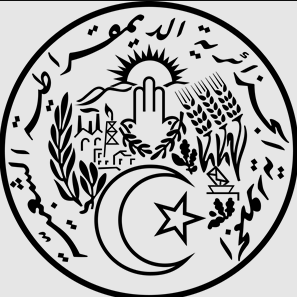The Algeria National Emblem is an important symbol that represents the country's rich history, culture, and values. The emblem is a powerful image that reflects the country's identity and has undergone several changes over the years. In this article, we will delve deeper into the history of the Algerian national emblem, its current design, and the significance of its elements. We will also discuss its relevance to the country and its people.
The History of the Algeria National Emblem
The Algerian national emblem has a long and complex history that dates back to the country's independence from France in 1962. The first national emblem of Algeria was designed by a group of artists led by Mohammed Racim, a renowned calligrapher and artist. The emblem featured a crescent and a star, which are traditional symbols of Islam, and was surrounded by olive and oak branches, which symbolize peace and strength, respectively.
In 1971, the national emblem was changed to include the "Hand of Fatima," a traditional symbol in Algerian culture that represents protection against the evil eye. The emblem also featured a rising sun, which symbolizes the dawn of a new era for Algeria.
In 1984, the national emblem was again redesigned to include the Atlas Mountains, which are a symbol of Algeria's natural beauty and strength. The emblem also featured a golden ribbon that bears the country's name and a pair of crossed sabers, which represent the country's struggle for independence.
The Current Design of the Algeria National Emblem
The current design of the Algerian national emblem was adopted in 1996 and features several important elements that reflect the country's identity and values. The emblem is circular in shape and is divided into two parts: the upper part and the lower part.
The upper part of the emblem features a gold sun rising over a red field, which symbolizes the blood shed by Algerians during their struggle for independence. The sun has 32 rays, which represent the 32 provinces of Algeria.
The lower part of the emblem features a traditional Algerian landscape with the Atlas Mountains, palm trees, and a river. The landscape also includes a white dove, which represents peace, and a pair of crossed olive branches, which symbolize the country's commitment to peace and diplomacy.
The Significance of the Elements of the Algeria National Emblem
The elements of the Algerian national emblem have deep significance and reflect the country's rich history, culture, and values. The crescent and star represent Islam, which is the predominant religion in Algeria. The Hand of Fatima is a symbol of protection and is widely used in Algerian culture.
The Atlas Mountains represent the country's natural beauty and strength, while the crossed sabers represent the country's struggle for independence. The olive and oak branches represent peace and strength, respectively, while the rising sun represents the dawn of a new era for Algeria.
The Relevance of the Algeria National Emblem
The Algerian national emblem is a symbol of the country's rich heritage and identity. It is a powerful image that represents the country's struggle for independence and its commitment to peace and diplomacy. The emblem is displayed on the country's flag, official documents, and public buildings, and is a source of pride for Algerians around the world.
The national emblem also has practical applications, such as being used on the country's currency, postage stamps, and passports. It is a symbol that is recognized worldwide and is an important part of Algeria's image and brand.
FAQs
- What is the history of the Algerian national emblem?
The Algerian national emblem has undergone several changes since the country's independence from France in 1962.
- What are the elements of the Algerian national emblem?
The current design of the Algerian national emblem features a gold sun rising over a red field, 32 rays representing the 32 provinces of Algeria, the Atlas Mountains, palm trees, a river, a white dove, and a pair of crossed olive branches.
- What is the significance of the crossed sabers in the national emblem?
The crossed sabers in the national emblem represent the country's struggle for independence from France.
- Why is the national emblem an important symbol for Algeria?
The national emblem is an important symbol for Algeria as it represents the country's rich history, culture, and values. It is a source of pride for Algerians around the world and is recognized as an important part of the country's image and brand.
- Where is the Algerian national emblem displayed?
The Algerian national emblem is displayed on the country's flag, official documents, public buildings, currency, postage stamps, and passports.
Conclusion
In conclusion, the Algerian national emblem is a powerful symbol that represents the country's rich heritage and identity. It has undergone several changes over the years, each reflecting a different aspect of the country's history and values. The current design of the emblem includes several important elements that symbolize Algeria's natural beauty, strength, and commitment to peace and diplomacy. The emblem is an important part of Algeria's image and brand and is recognized worldwide. It is a source of pride for Algerians around the world and will continue to be an important symbol for generations to come.
References
- "National emblem of Algeria." Wikipedia. https://en.wikipedia.org/wiki/National_emblem_of_Algeria
- "Symbols of Algeria." Embassy of Algeria in Washington, D.C. https://algerianembassy.org/symbols-of-algeria/
- "The National Emblem." Presidency of the Republic of Algeria. https://www.presidence.dz/en/the-national-emblem/
